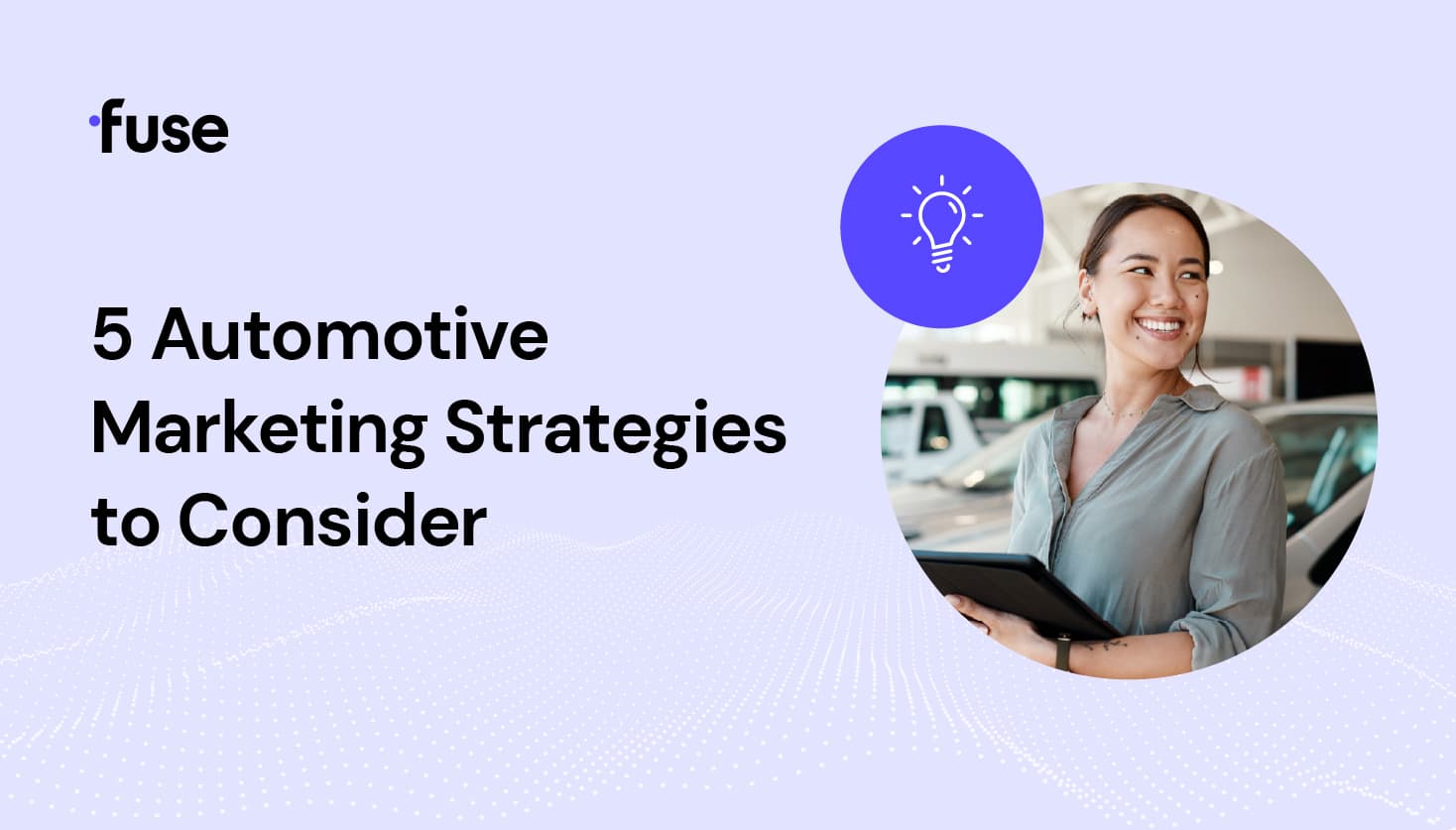Thursday, September 23rd at 11:00 AM ET
Nulla ut nisl a tellus pretium efficitur

By: Tom Ryan
14 minute read
The car buying process has evolved substantially over the years. What used to be an entirely in-person experience is now often initiated online and finalized in person. By the time most car buyers walk into a showroom, they already know what in-stock vehicle they’d like to purchase and at what price.
95% of modern-day car shoppers start the process online. From researching vehicle reliability and cost-of-ownership to reading dealership reviews and customer testimonials, today’s consumers are much more tech-savvy and research-inclined than those in decades past.
What used to be a quick Kelley Blue Book price check or Google search is now a multifaceted process. In this article, I’ll be exploring five automotive marketing trends for 2022 while sharing insights and contributions from AutoLeadStar along the way.
It should come as no surprise that these automotive marketing trends are heavily influenced by technology. As the primary driver in shifting consumer behavior, technology has reshaped the car buying experience.
As we explore these car marketing trends, we’ll also delve into the technology that’s accelerating them.
The top trend of 2022 is all about the customer experience and its impact on the car buying journey. Customer experience for dealerships encompasses customer service, sales and satisfaction, and the pre-buying experience.

According to Deloitte, customers who have positive experiences with a brand spend 140% more than those who report negative experiences.
Consumers have a new set of expectations post-pandemic. Businesses that delivered an exceptional customer experience throughout the uncertainty of lockdown generally came out ahead of those that did not.
This is key, as history proves that market share gained during a market disruption is less expensive to acquire and more easily sustained and defended when the market returns to normal.
To stay open during and after the height of the pandemic, businesses had to rely on technology. This brief overview explains how each piece of tech has impacted the car industry and how dealerships can use them to deliver a better customer experience.
60% of all online searches for vehicles originated on mobile, with many of the top searches on mobile devices centered around dealerships. Even after arriving at a dealership in-person, 59% of new car buyers will still use their smartphone for research.
According to Arianne Walker, Senior Director of Automotive Media and Marketing Solutions at J.D. Power, “This interplay between the dealership experience and digital information has become more intertwined with the availability of shopping content on mobile devices.”
top-of-mind for stores. As the majority of consumers start — and later continue — their new vehicle research from phones and other mobile devices, ensuring a website is mobile-optimized (as opposed to simply mobile-friendly) is essential.
If a picture was worth 1,000 words when Fred R. Barnard popularized the phrase in 1921, imagine how many words a video would be worth. When it comes to car shopping, videos of in-stock vehicles are worth the sticker price of every vehicle on the lot.
In a Google survey, 75% of auto shoppers reported that they are influenced by videos. In another study, 73% of people reported that videos helped them make a product or service purchasing decision.
Personalized videos allow dealerships to address customers’ questions and deliver a custom shopping experience to countless people before anyone even walks through the door.
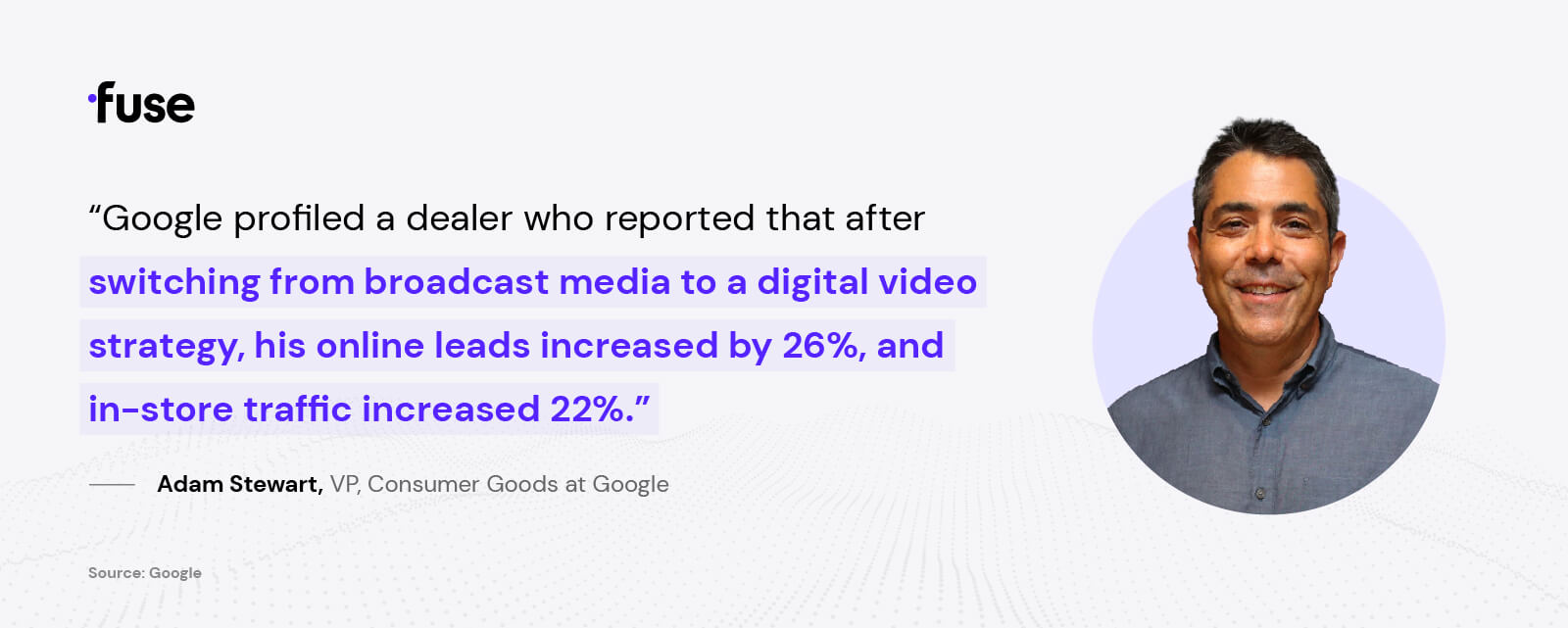
Thanks to video-sharing platforms like YouTube, Instagram, TikTok, and others, dealerships can publish video content for prospective buyers to find and consume at their convenience. Video assets can also be leveraged in dealership email marketing, website landing pages, and vehicle listing pages. These are even more effective with well-produced videos using team members rather than automated products.
Google profiled a dealer who reported that, after switching from broadcast media to a digital video strategy, online leads increased by 26% and in-store traffic increased by 22%.
With 56% of surveyed car buyers reporting they’d purchase a vehicle sight unseen from a 360-degree view only, it’s no wonder why brands like BMW and Audi are using this technology to create virtual showrooms. I expect to see more dealerships and carmakers follow suit as demand for more immersive shopping experiences continues to rise.
Along with boosting dealership sales, technology has created a higher expectation from car buyers for a fast, seamless experience. Chatbots and messaging apps have helped dealerships meet this demand.

90% of car dealers in North America will use some form of messaging technology in 2022. Both human-driven and AI-driven chatbot options have pros and cons, but dealerships that ignore the need for messaging altogether will lose. Humans running the chat feature can provide a custom experience, while AI-led chatbots offer more consistency and around-the-clock support.
Not everyone who shops at a dealership will utilize the chatbot messaging functionality. However, those who prefer to communicate via chat are more likely to make a purchasing decision with the dealership offering their preferred communication channel. Just be sure your dealership has a strong business development center (BDC) in place to follow up with and convert those leads.
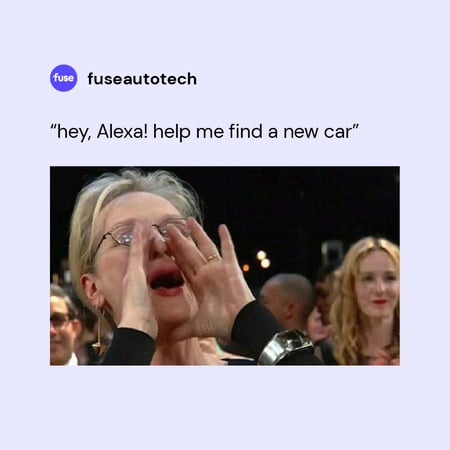
According to Forbes.com, Amazon and Google account for 27 million voice-activated devices sold in the US alone. More and more, people rely on devices with voice search when shopping for new or pre-owned vehicles.
The increased use of voice search means car dealerships need to start thinking about optimizing their websites and upleveling their search engine optimization (SEO) strategies to compete for voice search. This is important, as websites that rank in “position zero” of Google — also known as the featured snippet — will have their content read and cited out loud by smart devices. Additionally, a recent study by Search Engine Watch found that featured snippets account for 35.1% of all clicks in Google search results, leading to higher website traffic from new visitors.
Dealerships looking to capitalize on the rising popularity of voice search should act sooner than later by taking steps to boost search engine rankings. Blog posts that answer common questions support how shoppers search and find information online and can help dealerships compete in this technology space.
.gif?width=450&name=Fuse-Blog-Automotive-Marketing-Trends-5-Strategies-for-Success-IMAGES-6-(900x900-selective128colors-diffusiondither60-lossy20-26frames-transpoff-notranspdither).gif)
Community Connection
After two years of lockdown restrictions and stay-at-home orders, many Americans are eager to return to in-person events. Dealerships can take advantage of this opportunity by becoming more involved in their local communities once again.
Today’s consumers are more environmentally, community, and morally conscious. They prefer to shop with businesses that share their values. As staples in their local communities, dealerships should consider community involvement like sponsoring local events and volunteering with non-profit organizations.
Leveraging social media and becoming involved on hyper-local platforms like NextDoor can provide dealerships with insights into upcoming local community events.
While technology does and will continue to be necessary, human connection remains a focal point for modern-day consumers.
>> Download the Guide - Driving Dealership Customer Satisfaction and Profits with the Modern Retail Approach
Having covered the role and impact of technology in today’s car buying process, let’s discuss automotive marketing strategies and their impact on a dealership’s success.
Once again, technology sits at the center of the top automotive marketing strategies in 2022. Here are a few ways dealers can use this marketing tech for continued success:
Never underestimate the power of a review to help or hurt a business.
Dealerships should always strive to exceed customer expectations and request an online review as part of the sales process. Dealers should have a preferred platform for online reviews and share it openly with customers.
Good reviews are always ideal, but a bad review offers dealerships an opportunity to address the reviewer’s concerns publicly. A bad review can turn into sales for a dealership if addressed properly.
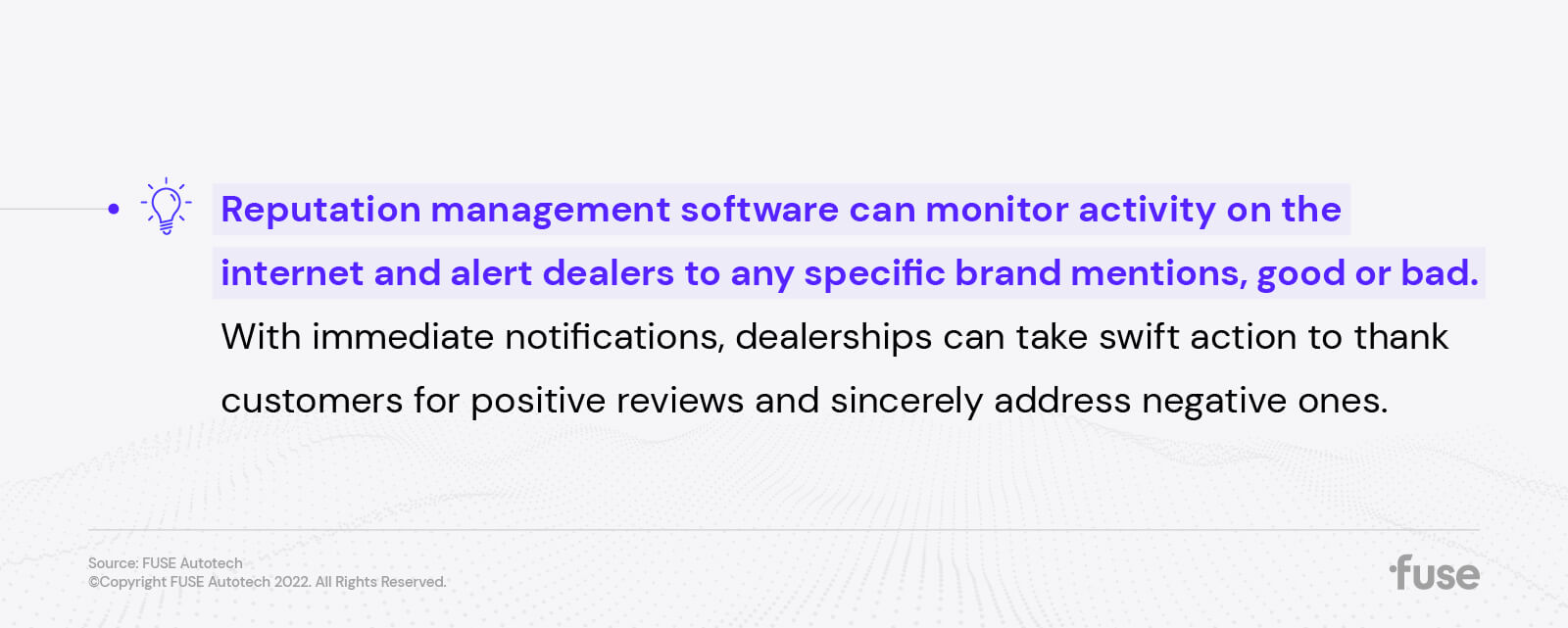
Reputation management software can monitor activity on the internet and alert dealers to any specific brand mentions, good or bad. With immediate notifications, dealerships can take swift action to thank customers for positive reviews and sincerely address negative ones.
The online image and reputation of a business are as valuable and worth protecting as the physical dealership itself. Those dealerships that remember this will do well in managing consumer perceptions.
In the local car dealership world, getting found online is critical. A strong dealership marketing program backed by content and local SEO (including the claiming, updating and maintaining of dealership Google My Business profiles and review site listings) is the path to success.
Here are a few reasons why:
Whether hiring outside support or standing it up in-house, a content marketing program that includes search-engine-optimized content will help dealers get found online organically while providing value to potential customers.
Buying a car is a big investment and, often, an emotional one. The shopping experience shouldn’t be impersonal.
To help meet changing customer demands, more dealerships are adopting the single-point-of-contact (SPOC) sales approach because it provides shoppers with a curated experience from beginning to end.
Dealers who aren’t ready to implement a SPOC sales model should still focus on personalizing the car buyer’s experience. By exploring different communications channels and offering a variety of ways for people to connect, dealerships can appeal to a broader audience and foster long-term customer relationships.
After the sale, staying in touch with customers can help a dealership stay top-of-mind for future purchases and referrals. Sending a note of thanks after making the sale, emailing curated specials for routine maintenance, and inviting past customers to appreciation or community events are all ways dealerships can stay relevant after closing a deal.
A U.S. Auto Industry Digital Ad Spend Survey published by Statista reports the automotive industry spent $14.96 billion on digital advertising. The report predicts that number will climb to $17.01 billion by the end of 2022 and to $19 billion in 2023. It’s not surprising that dealerships see the majority of website traffic coming from this source.
Dealerships that aren’t promoting their store through digital ads are missing out. But knowing that paid advertising is needed and executing a strategy are two different things.
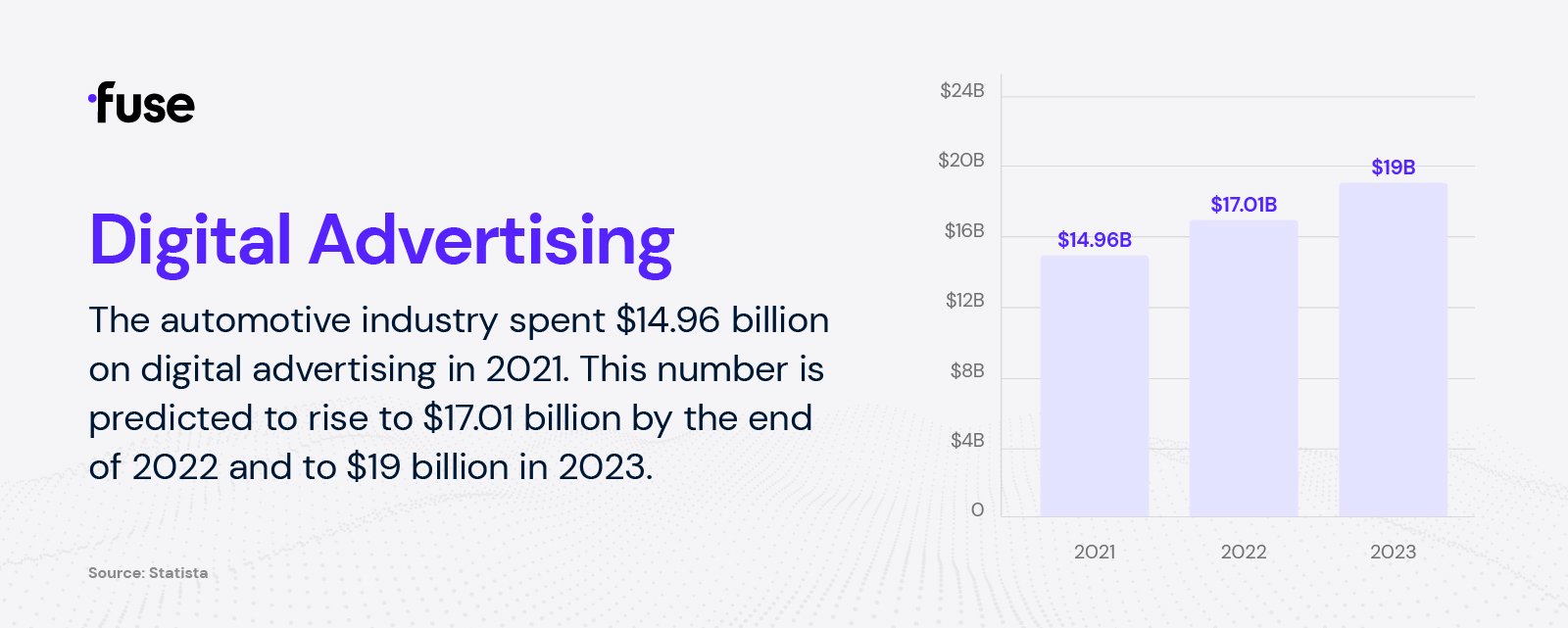
Before running any online ads, dealerships need to understand who they should target. Those taking the task in-house should look for opportunities to use existing data to inform their paid ad strategy. A dealership’s CRM is an excellent source of knowledge to build custom lookalike audiences for paid ad targeting. Leveraging this resource can help determine the type of buyer to target with Google Ads, along with any additional demographic information needed. The data can then be used to further refine the audience for future campaigns.
However, understanding how best to manage paid ad spend is often left to ad agency professionals. One way to know if your agency pros truly have the chops to maximize paid ad spend for your dealership is to check to see if they’re bidding against terms already targeted by original equipment manufacturers (OEMs). If so, they’re wasting your money bidding on terms you simply cannot win.
Regardless of how paid advertising is approached, dealerships that want to compete and stay relevant in this hyper-competitive market should take action.
One surefire way to boost sales is to have an “always-on” strategy. An effective automotive marketing automation campaign puts dealership offers where buyers can see them.
Dealership software that dynamically updates website specials and digital ads based on current and incoming inventory will provide buyers with the most current deals online. By having the latest finance, APR, lease payments, and incentives for each in-stock vehicle linked with marketing automation software, dealers can gain a competitive edge.

Dealerships are also using automation software to help keep ad spend budgets lean. Walser Honda provides a great example of how adaptable marketing automation can be and why it should be integral to every dealership’s strategy. After implementing AutoLeadStar Acquire in February 2020, the Acquire platform allotted 12% of the group’s ad spend to social media. However, as the market drastically changed due to COVID-19 and government lockdowns, people began spending more time on social platforms.
Recognizing this shift, the Acquire program used machine learning to instantly identify, target, and reassess where in-market buyers were spending their time and increased the ad budget across social channels to 26% in April and May. As a result, the auto group’s cost per lead decreased from $50 in February and March to $36 in April and May, simultaneously bringing down the group’s costs per click.
“Without automation, we would never have been able to maintain or exceed our pre-COVID-19 performance. AutoLeadStar has given us the opportunity to react fast and deploy campaigns instantly. A team of 10 people couldn’t do what AutoLeadStar Acquire can do in seconds.” — Matthew Muhlenkort, SEM Analyst, Walser Automotive Group
>> Sign Up for Email Updates - Get Great Content Like This Delivered Right to Your Inbox
As a parting thought, I want to circle back to the importance of investing in the right technology, as it is integral to the strategies outlined above.
Fuse’s automotive retail solutions improve the customer experience by ensuring potential car buyers get instant access to the most up-to-date offers and payment information from dealerships’ digital ads and website specials pages. The fintech software also enables more personalized, single-point-of-contact transactions in-store.
Equally vital to the implementation and success of these strategies is an investment in ongoing support and training to ensure the customer car-buying process remains optimized and the technology continues to be fully utilized (rather than retired to the proverbial graveyard of past dealer software solutions).
As a parting thought, I want to circle back to the importance of investing in the right technology, as it is integral to the strategies outlined above and to the continued success of auto dealerships.
Get in touch today to find out how Fuse can take your customer experience to the next level and position your dealership for long-term success.
>> See How Fuse Transact Works - Watch the Video Now
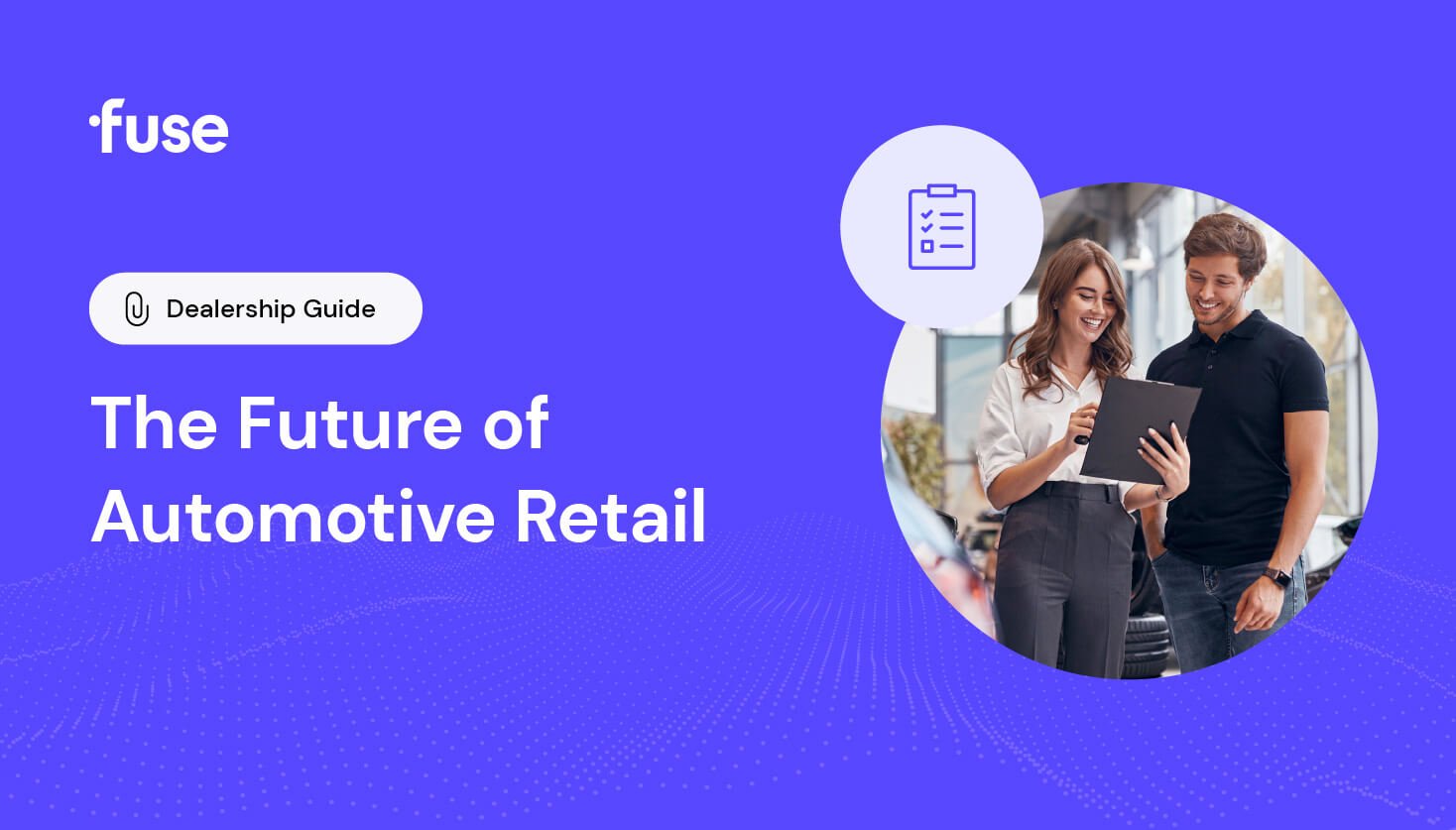
Today’s electric and hybrid cars appear nearly unrecognizable when compared to the first gas-powered car models created in the 1880s. The same cannot be said for the actual process of buying a...
News and Insights
10 min read
